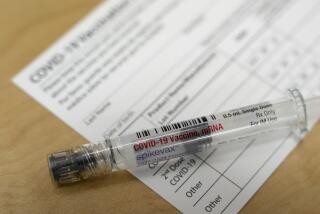2 Vaccines Sharply Decrease Grave Diarrhea Cases
- Share via
Two competing vaccines designed to combat rotaviral diarrhea, one of the world’s leading causes of childhood death, sharply reduced severe disease and hospitalizations, according to the results of two unusually large clinical trials released Wednesday.
In the developing world, widespread vaccinations would significantly decrease the 600,000 fatal cases annually of children younger than 5, experts said.
In the United States, where readily available medical care limits deaths to about 40 a year, routine vaccine use could eliminate most of the 70,000 disease-related hospitalizations and 87% of the workdays missed by parents, saving billions of dollars, according to the studies, published in the current New England Journal of Medicine.
“After a long period of waiting, the time for a rotavirus vaccine may have finally arrived,” wrote Drs. Roger I. Glass and Umesh D. Parashar of the Centers for Disease Control and Prevention in a journal editorial.
The two vaccines were developed in response to the 1999 withdrawal of RotaShield, a vaccine with a rare but potentially fatal side effect. Even countries with numerous rotavirus deaths shunned the vaccine as a result.
The new clinical trials should boost confidence in vaccination in the U.S. and abroad. Africa and Asia account for 85% of all rotavirus deaths.
Acceptance in the U.S. is “critically important,” added Dr. Jon Kim Andrus of the Pan American Health Organization in Washington, D.C. “A lot of countries develop their policy because of the experience accumulated over the years in the United States.”
Hurdles remain before the vaccines can be widely used overseas.
The first is demonstrating through clinical trials in Asia and Africa that the vaccines work as well there as they do in the Americas and Europe. Such trials are underway in South Africa and Bangladesh.
A larger hurdle is paying for the vaccine. In Africa, as many as half of the children in some areas are not inoculated against the most common diseases because public health agencies cannot afford $1 for each combined vaccine. The rotavirus vaccines are projected to cost more than $100.
The vaccines are making their way to patients. Based on the trial results, which were submitted to overseas regulators before publication, GlaxoSmithKline’s Rotarix has been licensed in a dozen countries, primarily in Central and South America. The governments of Panama and Brazil recently announced that they had purchased sufficient quantities of the vaccine to immunize all their children this year.
In the U.S., a Food and Drug Administration panel has recommended that Merck & Co.’s RotaTeq vaccine be approved, and it might be licensed within months. GlaxoSmithKline is expected to apply soon for FDA approval for Rotarix.
If the vaccines are approved by the FDA, “certainly there will be a greater commitment to the use of these vaccines, in the middle-income countries at the very least,” said Dr. Mark Miller of the Fogarty International Center at the National Institutes of Health.
More widespread use will ultimately lead to lower prices, he added.
The two new vaccines appear to have none of the side effects connected with RotaShield, which was introduced by drug maker Wyeth in 1998.
RotaShield was based on a genetically engineered rhesus monkey rotavirus. It produced fevers in about a third of the children vaccinated, according to Dr. Richard L. Ward of the Cincinnati Children’s Hospital Medical Center.
The vaccine was withdrawn from the U.S. after 11 months because of reports that it could cause a potentially fatal intestinal blockage, intussusception. Subsequent research showed that the risk of intussusception was much lower than had originally been thought, and less than 1% of the risk of death from rotavirus, Miller said. “But by then, the damage was already done.”
Merck’s RotaTeq vaccine is based on a genetically modified cow rotavirus, which is much less likely to produce fever. GlaxoSmithKline’s Rotarix vaccine, originally developed by Ward, uses a human rotavirus whose pathogenicity has been eliminated by growing it in laboratory cultures repeatedly -- the same technique used to make the oral polio vaccine.
Neither of the vaccines appeared to produce unusual numbers of intestinal blockages in the trials. In fact, the groups that received placebos experienced more blockages than those getting the vaccines.
The Rotarix trial involved 63,000 infants in 11 Latin American countries and Finland. Half received vaccine doses at age 2 months and 4 months; the rest received a placebo. The vaccine reduced serious illness by 85% and hospitalizations for diarrhea by 42%, the team reported.
The RotaTeq trial involved 68,000 infants in the U.S. and 10 other countries. Each infant received three doses of vaccine or placebo at intervals of four to 10 weeks. The vaccine reduced the incidence of severe disease by 98% and diarrhea-related hospitalizations by 63%, the report said.
The reductions in hospitalizations for diarrhea were “particularly exciting,” Glass and Parashar wrote, because the figures indicate that previous studies underestimated the proportion of diarrhea-related hospitalizations caused by rotaviral infections and that rotavirus plays a larger role than previously believed.







